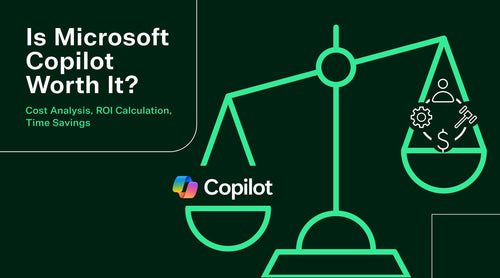As enterprise AI adoption speeds up, Microsoft Copilot is notable for its tight integration with Microsoft 365. But at $30 per user each month, many IT and business leaders wonder: Is Copilot worth the cost? The answer depends on how you evaluate value.
This article explains the true cost of Copilot, how to justify it to your executive team, and which metrics to monitor to guarantee you're maximizing your return on investment (ROI). Supported by solid data and real-world results.
Licensing and Cost Considerations
Microsoft Copilot is not part of standard Microsoft 365 or Office 365 plans; it’s a premium add-on for eligible enterprise users.
Key Pricing Details:
- Cost: $30/user/month
- Eligibility: Available to customers with Microsoft 365 E3/E5 or Office 365 E3/E5 licenses
- Includes: Access to Copilot features in Word, Excel, Outlook, PowerPoint, Teams, and more
While this increases your software costs by $360 per user annually, it unlocks the potential for enterprise-wide AI productivity improvements.

The Argument for Copilot Cost Justification
Let’s consider a simple productivity math model:
According to a Forrester Economic Impact Study, Copilot saves a general user 8 hours a month and up to 20 hours for highly sophisticated users, amounting to 96–240 hours annually. At a $30/hour wage, that equals $2,880–$7,200 in yearly labor savings, all for just a $360 investment.
And this doesn’t account for indirect savings such as quicker project completion, fewer revisions, or increased employee satisfaction.
Real ROI: How Copilot Provides Tangible Value
While $30/month may raise budget concerns, Copilot isn’t a speculative expense; it’s a force multiplier for knowledge workers. Here are three key areas where Copilot pays off:
Labor Cost Savings
Copilot reduces time spent on repetitive tasks like:
- Drafting emails or reports
- Summarizing meetings or documents
- Generating formulas and visuals in Excel
These task reductions can save users dozens of hours each month, especially in roles with heavy content. Companies like Siemens report that Copilot decreases the time needed to create documentation by up to 40%.
Department-Specific Impact
Teams in HR, legal, finance, sales, and IT experience the quickest return because of high document and communication workloads. Example time-saving tips:
- Legal: Summarizing NDAs or policies
- HR: Generating onboarding guides or performance review templates
- Finance: Automating budget report drafts
- IT: Writing PowerShell scripts or summarizing tickets
Quality and Accuracy Improvements
Copilot users report:
- Fewer revisions required in documents
- More polished content
- Higher first-pass accuracy on tasks such as meeting notes, email responses, or documentation.
According to Microsoft’s internal study, users finished Word documents 12% faster with Copilot and often achieved higher-quality results with fewer revisions. In fact, Copilot licensees were able to complete tasks nearly half a day sooner, and 78% of users agreed it enhanced the quality of their work.

Forrester's Study on the The Total Economic Impact™ Of Microsoft 365 Copilot states: Copilot is more than just a productivity tool; it’s a strategic investment for long-term growth:
- 6% increase in net revenue
- 20% reduction in operating costs
- 25% acceleration in new-hire onboarding
“Upskilling on AI now is absolutely critical to being prepared for its capabilities in a few years. In five years, running a business without Copilot would be like trying to run a company today using typewriters instead of computers.”
—Forrester Study: Head Vice President of Technology Services, IT Services and Business Consulting
Key Metrics to Track Copilot ROI
To get executive buy-in or validate your investment, use these quantifiable metrics:
| Metric | Why It Matters | How to Track |
|---|---|---|
| Usage Frequency | Adoption shows value | Track daily/weekly Copilot commands per user |
| Time Saved Per Task | Measures productivity gain | Compare pre- and post-Copilot task times |
| License Utilization | Optimize cost | Identify % of licensed users actively using Copilot |
| Error/Revision Reduction | Confirms output quality | Monitor doc revisions and user feedback |
| Automated Workflows | Shows AI scale | Count AI-driven processes by team |
5 Tips to Maximize Copilot ROI
- Start with high-impact departments: Legal, sales, IT, and HR
- Train users well: ROI relies on effective prompting skills.
- Use prompt libraries: Share the best examples to establish a standard for success.
- Track usage data: Use Microsoft 365 analytics and feedback surveys
- Don’t over-license: Begin with key users, then expand gradually.
Final Verdict: Is Copilot It Worth It?
If deployed properly, Copilot can pay for itself 10–20 times over, especially in knowledge-intensive environments. The key is to:
- Roll out strategically
- Train users effectively
- Monitor value over time
For companies focused on operational efficiency, productivity, and empowering employees, Microsoft Copilot is well worth the investment, as it offers a true competitive edge.
Next Step: Is Your Organization Copilot-Ready? Before you deploy, make sure your environment is secure, compliant, and optimized. Take our Copilot Readiness Assessment.
https://trustedtechteam.co.uk/pages/microsoft-copilot
Sources
Forrester Consulting. The Total Economic Impact™ of Microsoft 365 Copilot. Microsoft, 2024, https://tei.forrester.com/go/microsoft/M365Copilot/?lang=en-us
Microsoft. “Microsoft 365 Copilot Drove up to 353% ROI for Small and Medium Businesses: New Study.” Microsoft 365 Blog, 17 Oct. 2024, https://www.microsoft.com/en-us/microsoft-365/blog/2024/10/17/microsoft-365-copilot-drove-up-to-353-roi-for-small-and-medium-businesses-new-study/
Nucleus Research. “Microsoft and Siemens Announce Copilot Partnership.” Nucleus Research, 24 Apr. 2024, https://nucleusresearch.com/research/single/microsoft-and-siemens-announce-copilot-partnership/
Rai, Dheeraj, et al. “Copilot: How Effective Is Microsoft’s Assistant in Software Development?” arXiv, 2024, https://arxiv.org/html/2504.11443v1















